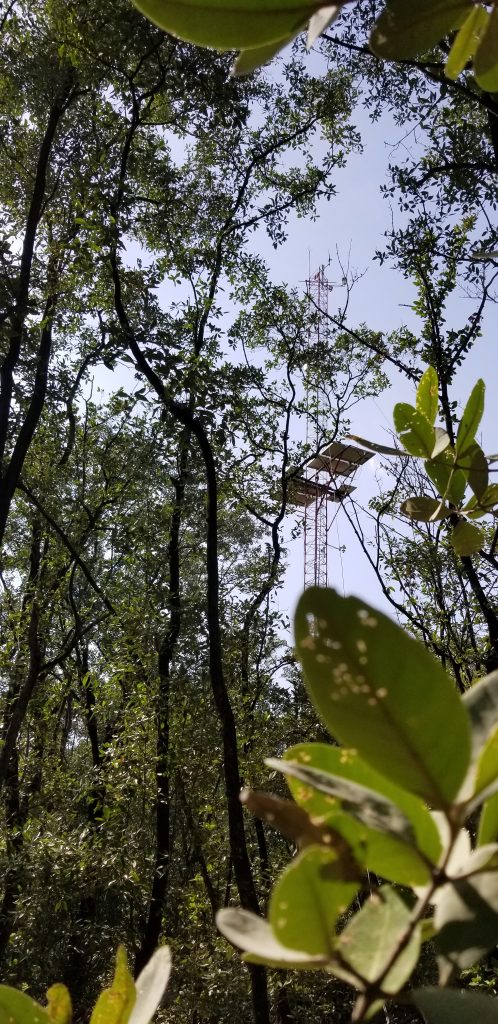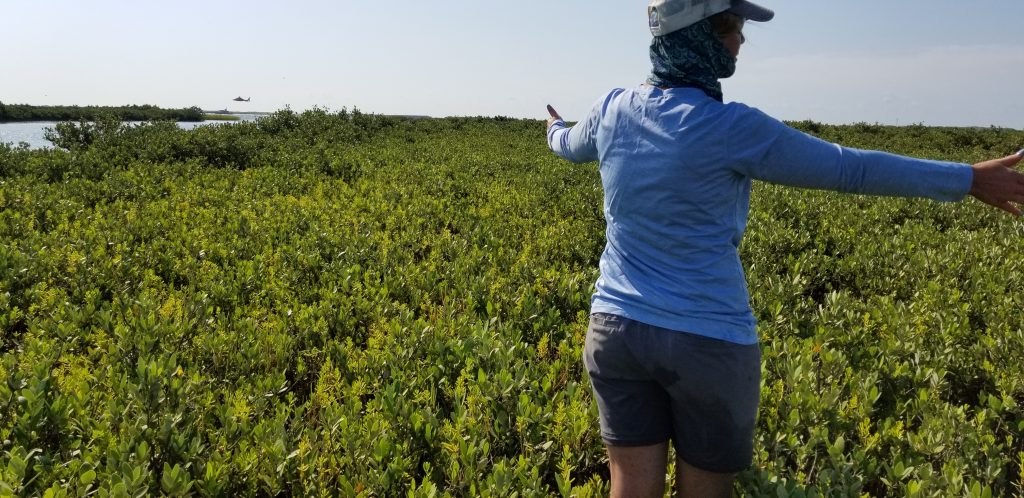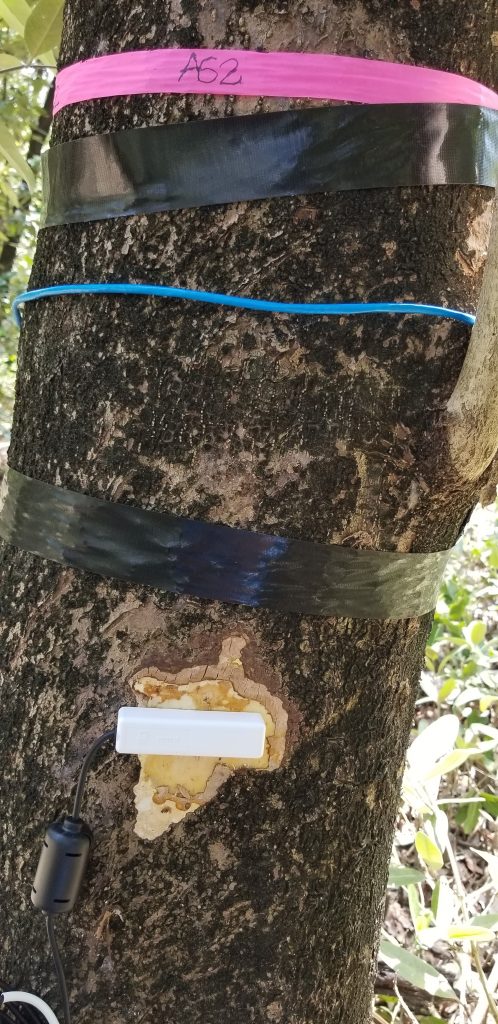Halophyte Hydrodynamics
Exploring halophyte hydrodynamics and the role of vegetation traits on ecosystem response to disturbance at the terrestrial-aquatic interface

Mangroves grow along tropical and subtropical coastlines and intertidal zones, and are therefore very rarely limited by root-zone moisture availability. However, during the dry season, these ecosystems have been shown to behave more similarly to semi-arid ecosystems than like well-watered forests. The process of salt exclusion from sea- and brackish waters during root-water uptake provides an additional energy and rate limiting step in the soil-plant-atmosphere continuum. This adaptation is responsible for high xylem tensions that result in stomatal closure and reductions in transpiration, in spite of adequate water availability. Reductions in transpiration cause increase in sensible heat flux rather than latent heat leading to an energy balance characteristic of a water-limited system. Current land-surface modeling technologies use a semi-empirical relationship to connect stomatal conductance directly to soil moisture, and are unable to replicate the behaviors of halophytes leading to errors in energy balance partitioning throughout tropical coastlines.
We are developing a salt-tolerant root-water uptake model for the FETCH2 advanced vegetation hydrodynamics model that will be capable of mechanistically simulating osmoregulation by halophytic plants such as mangroves. The FETCH2 model will then be integrated into the land-surface model component of the DOE’s Energy Exascale Earth System Model (E3SM) as a replacement for the current direct link between soil moisture and stomatal conductance. FETCH2 approximates flow through the xylem of plants as a flow through porous media and accounts for dynamic changes to conductance and capacitance of plant tissues caused by changes in water content. Parameter sets within FETCH2 are based on measurable hydraulic traits including isohydricity, xylem and root vulnerability to hydraulic impairment (embolism), and rooting depth among others. However, studies have shown that these above and belowground hydraulic traits can be highly plastic and vary both spatially and temporally. Therefore, we will couple our model development with an extensive field study of mangrove hydraulic traits, their variability, and their influence on plant and ecosystem level fluxes of carbon, water, and energy.
Atmospheric demand for water vapor (VPD) and soil water availability are the primary determinants of vegetation water stress for terrestrial plants. Yet in the unique case of mangroves, salinity supersedes the control of soil water availability. Our study is designed to analyze mangrove forest function across both humidity and salinity gradients. We will combine ecosystem scale measurements of carbon, water, and energy flux with plant-level observations of sap flux, biomass water content, and leaf level gas exchange, and analysis of emergent above and below ground plant hydraulic traits in three field sites spanning a strong humidity gradient from Panama (humid), to the US Gulf Coast (subhumid), and Abu Dhabi (arid). Within each site, tidal influences, evaporation, and surface runoff create a salinity and water depth gradient from landward to ocean-ward edge. We propose to analyze trait plasticity along the axes of atmospheric response (across sites), salinity response (within sites), individual and species controls (individuals and species within and across sites), and temporal controls (across wet and dry seasons and years). This analysis of above and belowground trait plasticity will facilitate the development of a flexible parametric ‘trait-space’ for FETCH2. We hypothesize that such a trait-based plant hydrodynamics model will more accurately represent water, carbon, and energy exchange at the terrestrial-aquatic interface along tropical coastlines.
Our project team:
Ashley Matheny, Chonggang Xu (Los Alamos National Lab), Matteo Detto (Princeton University), Annalisa Molini (Masdar Institute at Kalifa University), Tim Shanahan (University of Texas at Austin), Ana Maria Restrepo Acevedo, Suvan Cabraal
Project News: 
July 2019:
Matheny and colleagues are awarded $0.89 million from the US Department of Energy Terrestrial Ecosystem Science Program to study and model mangrove forest responses to changing salinity and atmospheric conditions across an environmental gradient from humid (Panama), to subhumid (Texas), to arid (Abu Dhabi).
September 2019:
Good luck for the Halophyte Hydro team! We’ve be awarded a Networks of Excellence Grant by Monash University in Australia, with collaborators Edoardo Daly and Ruth Reef, to add a fourth mangrove field site to our project in French Island, Australia. While the French Island site shares a mangrove species with the Abu Dhabi site (Avicennia marina) it also represents the southern extent of mangrove habitat! Now, each site has a species in common with one other site (Panama and Texas both share Avicennia germinans) and we encapsulate the northern extent (Texas) and the southern extent (French Island) of the habitat range.
December 2019:
Matheny and colleagues present the theoretical framework for the project at the American Geophysical Union’s Fall Meeting in San Francisco, CA! You can click here: AGU-2019 to view our poster.
January 2020:
We have finally been approved by the Texas General Land Office to install our mangrove monitoring station at Port Aransas, TX in conjunction with the Mission Aransas National Estuarine Research Reserve! We are so grateful for the University of Texas’s Marine Science Institute’s help and collaboration throughout the process!!
February 2020:

Matheny, Detto, and PhD student Ana Maria Restrepo Acevedo travel to Panama City, Panama to install our vegetation hydraulics monitoring system in the Manglares Juan Diaz nature park. We discovered quickly that ants were not going to be our friends here, but fortunately our site technician Jaime Gonzalez is on the case installing newly fortified sap flow sensors and metal tree tags.
March and April 2020:
The Matheny crew had been planning a trip to Abu Dhabi to visit Co-PI Molini and install vegetation monitoring in Mangroves National Park, however, the COVID-19 virus had other plans. We are all ‘hunkering down’ and planning our next moves as we wait to resume our field campaigns.

